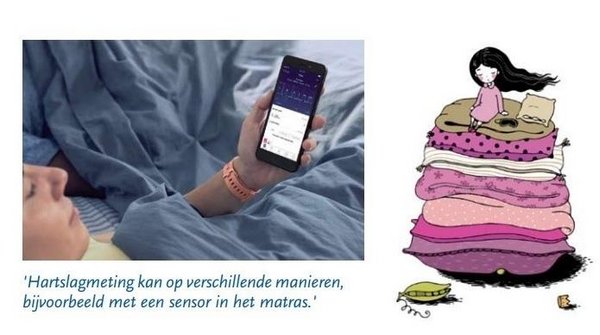Diagnosing sleep apnea can be done faster, easier and more costs-efficient, while causing less trouble for the patient and reducing the number of patients on waiting lists. Based on heart rhythm and movement, the quality of sleep is measured as well as the approximate number of apneas. This method can easily be used to confirm an earlier diagnosis. As measuring the heart rhythm is cheap and has little impact on the patient, it is simple to measure during a longer period of time, offering a better insight in the effect of treatment.

Traditionally, a somnologist makes a diagnosis following a polysomnography or polygraph study. However, if during a doctor’s consult there are clear indications concerning the breathing stops, more limited measuring methods may be used. Currently, ECG is the most reliable technique to measure heart rhythm. In measuring the heart rhythm, the number of beats per minute is as important as the exact time between heart beats. Prof. Overeem: “Newly developed software can now be applied in all gradations of sleep apnea. The computer recognizes patterns that are subsequently linked to the sleep stage and the occurrence of an apnea or hypopnea. It thus accurately analyses the hearth rhythm, maps breathing stops, and offers valuable information on the quality of sleep itself.” He continues: “If the patient’s story is clear and indicative of sleep apnea, a simpler technique such as heart rhythm monitoring will do. If not, you will need a more reliable measuring instrument.”

Heart rhythm measurements can be done in various ways, ranging from wires on the chest, sports watches and plasters to mattress sensors. Measuring during a longer period of time makes it easy to follow and guard the effect of the treatment. “When, for instance, the treatment does not show the desired effect, you can prolong the monitoring at home and detect other causes”, according to Overeem. As the testing quality of heart rhythm measurement is not the same as that of polysomnography, heart rhythm measurement is not the answer to all apnea-related complaints. Overeem concludes: “Developing new technology and software is a first step. We now have to determine when to use it and study the results. But at all times, a doctor’s consult is required.”
Writers: Leonie Vink and Mirjam Brennand - Center for Sleep Medicine Kempenhaeghe
Source: Interview with prof. dr. Sebastiaan Overeem in a recent article in Apneumagazine ( the magazine of the Dutch patient association for apnea patients).
Scientific article: ‘’Estimation of the apnea-hypopnea index in a heterogeneous sleep-disordered population using optimised cardiovascular features’’ by Gabriele B. Papini, Pedro Fonseca, Merel M. van Gilst, Johannes P. van Dijk, Dirk A. A. Pevernagie, Jan W. M. Bergmans, Rik Vullings & Sebastiaan Overeem.